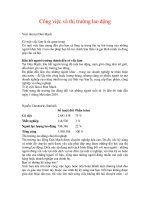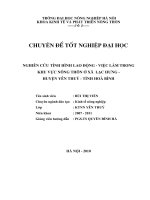Dinh nghia va tinh hinh lao dong viec lam nam 2022
Bạn đang xem bản rút gọn của tài liệu. Xem và tải ngay bản đầy đủ của tài liệu tại đây (487.13 KB, 26 trang )
<span class="text_page_counter">Trang 1</span><div class="page_container" data-page="1">
<small>MINISTRY OF PLANNING AND INVESTMENT</small>
<b><small>GENERAL STATISTICS OFFICE</small></b>
<b><small>SOCIALIST REPUBLIC OF VIET NAM</small>Independence - Freedom - Happiness </b>
<i>Ha Noi, dated 6 July 2022</i>
<b>REPORT ON THE POST-PANDEMIC RECOVERY OF EMPLOYMENT ANDLABOUR MARKET IN SECOND QUARTER OF 2022<small>1</small></b>
<b>1. Overall Context</b>
In the June 2022 Global Economic Outlook report, the World Bank stated that after more than two years of the pandemic, along with the effects from the conflict between Russia and Ukraine, global economic activity has decreased drastically, with the global growth expected to reach only 2.9 per cent in 2022, down 1.2 percentage points compared to the forecast made in January 2022. Economic activity in advanced economies has been held back by rising energy prices, unfavourable financial conditions and supply chain disruptions. As a result, growth in advanced economies is forecast to nearly halve, from 5.1 per cent in 2021 to 2.6 per cent in 2022, 1.2 percentage points lower than forecast in January 2022. Economic growth in developing and emerging economies is also forecast to halve this year, from 6.6 per cent in 2021 to 3.4 per cent in 2022, 1.2 percentage points lower than forecast in January 2022.
When it comes to labour and employment, according to the latest report of the International Labour Organization (ILO),<small>2</small> the recovery of the global labour market is being threatened by the ongoing crises that influence each other and increase inequality. Following the remarkable achievements in the fourth quarter of 2021, number of hours worked in the world has deteriorated in the first quarter of 2022 and remains 3.8 per cent below the level of the fourth quarter of 2019, equivalent to a deficit of 112 million full-time jobs. The ILO’s latest projection for the second quarter of 2022 shows that the level of hours worked is expected to be 4.2 per cent below the pre-pandemic level, which is equivalent to 123 million full-time jobs.
In the national context, the flexible responses together with constant efforts by the entire political system, from central to local, to recover and
<small>1</small><i><b><small> The data for the quarters of 2019 and 2020 in this report are recalculated according to the new ICLS 19</small></b></i>
<i><small>conceptual framework.</small></i>
<small>2</small><i><small> ILO Monitor on the world of work. 9th edition. 23 May 2022.</small></i>
</div><span class="text_page_counter">Trang 2</span><div class="page_container" data-page="2">develop the economy, have helped bring the Covid-19 pandemic under control, with most of production and business operations returning to the normal state as before the Covid-19 pandemic. The 31<small>st</small> SEA Games event was successfully held in Viet Nam, thus helping promote more vibrant trade, tourism and cultural activities as a spur for economic recovery. The socio-economic situation in the second quarter of 2022 in Viet Nam has prospered. Gross Domestic Product (GDP) in the second quarter of 2022 grew by an estimated 7.72 per cent over the same period last year, higher than the growth rate of the second quarters in the 2011-2021 period. In particular, the agriculture, forestry and fishery (AFF) sector increased by 3.02 per cent, contributing 4.56 per cent to the increase in total added value of the whole economy; the industry and construction sector increased by 8.87 per cent, contributing 46.85 per cent; and the services sector increased by 8.56 per cent, contributing 48.59 per cent. Viet Nam’s labour market in the second quarter of 2022 continued to maintain its recovery momentum. Both the total labour force and employed workers in the second quarter of 2022 increased relative to the previous quarter and over the same period last year in all three economic sectors. The average monthly income of workers increased relative to the previous quarter and over the same period last year. The statutory working-age unemployment and underemployment rates both decreased relative to the previous quarter and the same period last year.
<b>2. Impact of the Covid-19 pandemic on labour and employmentsituation</b>
<i><b>Efforts made to implement production, business and social lifeactivities, promptly address difficulties and challenges, and captureavailable time to accelerate the socio-economic recovery anddevelopment of the country have all brought a remarkable effect on theVietnamese labour market. The labour force has grown rapidly. Thenumber of workers negatively affected by the Covid-19 pandemicdecreased significantly.</b></i>
The labour force aged 15 and older in the second quarter of 2022 was 51.6 million people, an increase of more than 0.4 million people compared to the previous quarter and an increase of nearly 0.6 million people on a year-on-year basis. Compared to the previous quarter, the rural and urban labour forces both increased (by 0.3 million people and 0.1 million people, respectively), the female labour force increased more than the male labour force (0.3 million female workers versus nearly 0.2 million male workers).
<small>2</small>
</div><span class="text_page_counter">Trang 3</span><div class="page_container" data-page="3">Compared to the same period last year, the labour force increased in urban areas (up 0.6 million people) and slightly decreased in rural areas (down 0.06 million people).
</div><span class="text_page_counter">Trang 4</span><div class="page_container" data-page="4"><b>Figure 1: Labour force by quarter, 2020-2022</b>
<i> Unit: Million people</i>
In the second quarter of 2022, Viet Nam recorded just over 8.0 million people aged 15 and older who were negatively impacted by the Covid-19 pandemic, down more than half compared to the previous quarter (equivalent to a decrease of 8.9 million people) and down 4.8 million people over the same period last year.
Of a total of more than 8.0 million people negatively affected by the pandemic, 0.4 million people lost their jobs, accounting for 5.3 per cent; 0.5 million people could not find jobs, accounting for 5.7 per cent; 2.2 million people had to take a furlough or suspend production and business activities, accounting for 27.6 per cent, 2.4 million people had their working hours cut or were forced to work alternative shifts, accounting for 29.5 per cent and 6.5 million workers had their income reduced, accounting for 81.7 per cent. The Red River Delta is the region with a higher proportion of workers affected by the Covid-19 pandemic than other regions with 13.9 per cent, significantly higher than this figure in the Northern Midlands and Mountains and Central Highland, with 10.8 per cent and 8.1 per cent, respectively. 14.3 per cent of workers in urban areas were negatively affected, compared to the rural rate of 10.4 per cent.
<small>4</small>
</div><span class="text_page_counter">Trang 5</span><div class="page_container" data-page="5"><b>Figure 2: Number of people aged 15 and older negatively affectedby Covid-19 pandemic, fourth quarter of 2021, first and second quarters</b>
<i><b>The labour market recovered strongly in the second quarter of 2022;The Northern Midlands and Mountains, the Red River Delta and theSoutheast recorded the highest labour growth rates across the country.</b></i>
Employed workers aged 15 and older in the second quarter of 2022 were 50.5 million people, an increase of 504.6 thousand people (equivalent to 1.01 per cent) on a quarter on-quarter basis and an increase of 701.8 thousand people (equivalent to 1.41 per cent) year on year. Employed workers were 18.7 million people in urban areas (an increase of 127.9 thousand people or 0.7 per cent quarter on quarter and an increase of 673.7 thousand people or 3.7 per cent year on year), and 31.9 million people in rural areas (an increase of 376.6 thousand people or 1.2 per cent quarter on quarter and an increase of 27.9 thousand people or 0.1 per cent year on year). The increasing trend of employed workers was also observed for both women and men, although the growth rate of employed workers was higher among former than latter.<small>3</small>
The number of statutory working-age employed workers in the second quarter of 2022 reached nearly 45.0 million people, an increase of 856.0 thousand people (equivalent to an increase of 1.9 per cent compared to the previous quarter) and an increase of 1.0 million people (or an increase of 2.3 per cent over the same period last year. The growth rate of statutory working-age employed workers was higher than the overall growth rate of employed workers aged 15 and older, which shows very encouraging signs of the labour market.
<small>3</small><i><small> The growth rates of employed workers of men and women were 0.79 per cent and 1.25 per cent, respectively, relative to the previous quarter, and 1.40 per cent and 1.42 per cent, relative to the previous year.</small></i>
</div><span class="text_page_counter">Trang 6</span><div class="page_container" data-page="6">Compared to the previous quarter, the numbers of employed workers in statutory working age increased in most socio-economic regions. Of all regions, Northern Midlands and Mountains recorded the highest increase (increasing by 379.4 thousand people or 7.5 per cent), followed by the Red River Delta (increasing by 222.9 thousand people or 2.3 per cent), Southeast (increasing by 155.1 thousand people or 1.6 per cent).
The labour market continued its strong growth momentum of the previous quarter. The flexible approach to preventing the pandemic, the policy of completely opening up tourism activities, and the Socio-Economic Recovery and Development Programme under Resolution No. 11/NQ-CP dated January 30, 2022 are all the main drivers that brighten the picture of Viet Nam’s labour market in the second quarter of 2022.
<i><b>Employment in the services sector continued to prosper after thedecline hit the bottom in the third quarter of 2021</b></i>
In the second quarter of 2022, there were 19.8 million employed workers in the services sector, an increase of 429.8 thousand people relative to the previous quarter. This is the third quarter in a row since the decline hit the bottom in the third quarter of 2021 that the Vietnamese labour market recorded a strong increase in the number of workers employed in the services sector. In the most recent three quarters, on a quarterly average, this sector received nearly 900 thousand new workers, much higher than the growth rate of the other two sectors, i.e., AFF and Industry and Construction.<small>4</small>
<b>Figure 3: Employed workers in services sector by quarter, </b>
<small>4</small><i><small> The AFF sector decreased by more than 100 thousand people on average; the Industry and Construction sectorincreased by nearly 400 thousand people on average.</small></i>
<small>6</small>
</div><span class="text_page_counter">Trang 7</span><div class="page_container" data-page="7">The policy of completely opening up to tourism activities as from March 15, 2022 has been an important spur to help workers in the services sector gradually regain their pre-pandemic original state, thus generating a momentum for growth and development. Some industries in services sector recorded a high increase in employment. These include, for example, Wholesale and Retail Trade; Repair of Motor Vehicles and Motorcycles (an increase of 201.3 thousand people quarter on quarter and 341.5 thousand people year on year); Other Services Activities with an increase of 94.8 thousand people quarter on quarter and 47.8 thousand people year on year; and Accommodation and Food Services with an increase of 91.4 thousand people quarter on quarter and 24.1 thousand people over the same period last year.
<i><b>The labour market has indicated signs of sustainable growth</b></i>
In the second quarter of 2022, the number of informally employed workers was 21.4 million, an increase of 54.5 thousand people compared to the previous quarter and an increase of 499.0 thousand people over the same period last year. The number of informally employed workers in this quarter was 17.1 million people, an increase of 449.3 thousand people compared to the previous quarter and an increase of 1.6 million people compared to the same period last year. Compared to both the previous quarter and the same period last year, the number of employed workers in the formal sector increased much more than those in the informal sector. This suggests that the labour market has recovered in a sustainable manner.
The prevalence of non-AFF informal employment in the second quarter of 2022 was 55.6 per cent, down 0.6 percentage points compared to the previous quarter and down 1.8 percentage points over the same period last year. The urban informal employment prevalence was 47.5 per cent, down 0.6 percentage points from the previous quarter and down 1.1 percentage points from the same period last year, where the rural informal employment prevalence was 62.3 per cent, down 0.6 percentage points compared to the previous quarter and down 2.4 percentage points over the same period last year.
<i><b>Underemployment has improved significantly across the country,with underemployment in the services sector recording the biggestdecline</b></i>
</div><span class="text_page_counter">Trang 8</span><div class="page_container" data-page="8">The implementation of the Socio-Economic Recovery and Development Programme as per the Resolution 11/NQ-CP with specific solutions, such as supporting workers to return to the labour market, and those currently employed in enterprises across the country, has contributed to promoting a strong recovery of the labour market in the second quarter of 2022. In particular, the number of underemployed people in the second quarter of 2022 was about 881.8 thousand people, down 447.1 thousand people compared to the previous quarter and 263.1 thousand people compared to the same period last year. The overall underemployment rate in the second quarter of 2022 was 1.96 per cent, down 1.05 percentage points compared to the previous quarter and down 0.64 percentage points over the same period last year. The statutory working-age<small>5</small> underemployment rate in urban areas was lower than in rural areas (1.37 per cent and 2.32 per cent, respectively). Thus, the underemployment status has improved significantly in both urban and rural areas relative to the first quarter of 2022 (i.e., a respective 2.39 per cent and 3.40 per cent).<small>6</small>
<b>Figure 4: Number and rate of statutory working-age unemployedpeople</b>
<b> by quarter, 2020-2022</b>
<small>5</small> <i><b><small> According to the provisions of the 2019 Labour Code, the statutory working age limit includes from 15 to 59</small></b></i>
<i><small>years old for men and from 15 to 54 for women (as of 2020 and earlier); from 15 to under 60 years old 3months for men and from 15 to under 55 years old 4 months for women (in 2021); from 15 to under 60 yearsold 6 months for men and from 15 to less than 55 years 8 months for women (in 2022).</small></i>
<small>6</small><i><b><small> The underemployment rate by quarter in 2020 was 1.07 per cent (Q1), 2.36 per cent (Q2), 1.96 per cent (Q3),</small></b></i>
<i><small>1.10 per cent (Q4) in urban areas; and 2.47 per cent (Q1), 3.32 per cent (Q2), 3.14 per cent (Q3), 2.20 per cent(Q4) in rural areas. The underemployment rate by quarter of 2021 was 1.52 per cent (Q1), 2.80 per cent (Q2),5.33 per cent (Q3), 4.06 per cent (Q4) in urban areas; and 2.60 per cent (Q1), 2.49 per cent (Q2), 3.94 per cent(Q3), 2.95 per cent (Q4) in rural areas.</small></i>
<small>8</small>
</div><span class="text_page_counter">Trang 9</span><div class="page_container" data-page="9"><small>Underemployed (thousand persons)Underemployment rate (%)</small>
In the first quarter of 2022, the statutory working-age underemployment rate was highest in the North and South Central Coast with 4.23 per cent; followed by the Mekong River Delta with 4.0 per cent. Be the second quarter of 2022, this rate was highest in the Mekong Delta with 3.17 per cent, followed by the North and South Central Coast with 2.79 per cent. In the first quarter of 2022, this rate was lowest in the Southeast with 1.60 per cent, but turning to the second quarter, this rate was lowest in the Red River Delta with 0.62 per cent. The underemployment status has improved significantly across the country; compared to the previous quarter, this rate in the second quarter decreased across all six socio-economic regions.
<b>Figure 5: Statutory working-age underemployment rate by socio-economic region, the first and second quarters of 2022</b>
<i>Unit: Per cent</i>
</div><span class="text_page_counter">Trang 10</span><div class="page_container" data-page="10">Across all the three economic sectors, compared with the previous quarter, the underemployed workers in the second quarter of 2022 in the services sector decreased the most. Of a total of 881.8 thousand underemployed people of statutory working age, the AFF sector recorded the largest underemployment share in this quarter with 48.5 per cent (equivalent to 427.5 thousand underemployed people); followed by the services sector accounting for 31.4 per cent (about 277.3 thousand people); industry and construction sector made up the smallest share with 20.1 per cent (about 177.0 thousand people). Compared to the previous quarter, the number of statutory working-age underemployed workers in the second quarter of 2022 decreased across all three economic sectors (with respective reductions of 68.8 thousand people, 182.6 thousand people and 195.6 thousand people). However, compared with the same period last year, the number of underemployed workers increased by 20.1 thousand people in AFF sector, decreased by 150.4 thousand people in industry and construction, and decreased by 132.8 thousand people in the services sector.
The higher the professional and technical qualifications, the lower the underemployment rate. The statutory working-age underemployment rate in the second quarter of 2022 was 2.33 per cent for workers without professional and technical qualifications; 1.82 per cent for those with elementary qualifications; 1.10 per cent for those with intermediate qualifications; 0.95 per cent for those with college qualifications; and 0.61 per cent for those with university or higher qualifications.
<b>The average monthly income of workers in the second quartercontinued to record an increase compared to the previous quarter,which is different from the normal trend observed over many yearsbut is a positive sign reaffirming economic recovery and growth afterthe pandemic.</b>
The average monthly income of workers in the second quarter of 2022 reached 6.6 million VND, an increase of 206 thousand VND compared to the first quarter of 2022. Observing the average monthly income of workers on a quarterly basis in recent years, including years preceding the Covid-19 pandemic, one can see that the fluctuation of workers’ income in the second quarter compared with the first quarter of this year is different from the observed normal trend of previous years. In the years from 2019 to 2021, workers’ income in the second quarters usually decreased relative
<small>10</small>
</div><span class="text_page_counter">Trang 11</span><div class="page_container" data-page="11">to the first quarter due to incremental income earned from year-end overtime hours worked and Lunar New Year bonuses typically paid in the first quarter. On the contrary, for this particular year, no decrease was observed in the average monthly income of workers in the second quarter relative to the previous quarter as in preceding years, but instead a positive growth was maintained relative to the previous quarter and over the same period last year. This is a sign that suggests that Viet Nam’s economy is growing positively and strongly. Compared to the same period in 2021, when the Covid-19 pandemic was rampant across many provinces, the average monthly income of workers in the second quarter of 2022 recorded an encouraging growth rate, up 8.9 per cent, equivalent to an increase of about 542 thousand VND; compared to the same period in 2020 when the Covid-19 pandemic first broke out in Viet Nam, the average monthly income of workers increased by 19.7 per cent, equivalent to an increase of nearly
<i><b>1.1 million VND. The life of workers has gradually returned to the normal</b></i>
state as before the Covid-19 pandemic.
<b>Figure 6: Average monthly income of workers in the first and second</b>
<b>The average monthly income of workers across socio-economicregions has improved significantly. Compared to the same period last year,the North and South Central Coast are the regions with the highest averageincome growth.</b>
The average monthly income of workers in the second quarter of 2022 in the North and South Central Coast recorded the highest growth rate among the six socio-economic regions compared to the same period last year, with the average income of 5.8 million VND, an increase of 12.9 per cent, equivalent to an increase of about 620 thousand VND compared to the same period in 2021. Da Nang, Khanh Hoa and Thua Thien Hue are the provinces with the
</div><span class="text_page_counter">Trang 12</span><div class="page_container" data-page="12">most significant growth in average monthly income. Compared to the same period in 2021, the average income of workers in Da Nang was 7.3 million VND, an increase of 9.7 per cent, equivalent to an increase of about 643 thousand VND; workers in Khanh Hoa earned an average income of 6.2 million VND, an increase of 15.5 per cent, equivalent to an increase of about 828 million VND; and workers Thua Thien Hue earned an average monthly income of 5.7 million VND, an increase of 15.8 per cent, equivalent to an increase of about 778 thousand VND.
<b>Figure 7: Average monthly income of workers by socio-economic region inthe second quarter of 2021 and the first and second quarters in 2022</b>
<small>Quarter II of 2020Quarter II of 2021Quarter I of 2022Quarter II of 2022</small> Meanwhile, the average monthly income of workers in the Southeast and the Red River Delta still remained higher than that of the remaining regions. Compared to the same period last year, the average monthly income of workers in the Southeast was 8.5 million VND, an increase of 8.5 per cent, equivalent to an increase of about 480 thousand VND. In particular, the income of workers in Ho Chi Minh City and Binh Duong has always topped the country ranking, with the income of 9.1 million VND/person/month and 8.9 million VND/person/month, respectively.
Workers in the Red River Delta earned an income of 7.7 million VND/person/month, which is the region with encouraging income growth compared to the same period last year, up 12.4 per cent, equivalent to an increase of about 790 thousand VND/person/month. Workers in Hanoi and Bac Ninh earned the average income among the top five provinces and cities with the highest income in the country; the income of workers in Ha Noi was 8.7 million VND/person/month, an increase of 8.8 per cent, equivalent to an increase of about 704 thousand VND, workers in Bac Ninh earned an average income of 8.3 million VND/person/month, an increase of 15.8 per cent,
<small>12</small>
</div><span class="text_page_counter">Trang 13</span><div class="page_container" data-page="13">equivalent to an increase of about 1.1 million VND relative to the same period in 2021.
<b>Figure 8: Five provinces and cities with the highest average monthlyincome of workers, second quarter of 2022</b>
<i><b>Average monthly income of workers increased in all threeeconomic sectors. Some broad industries recorded encouraging growthrates</b></i>
In the second quarter of 2022, the income of workers in all three economic sectors has recorded an encouraging growth rate. In particular, workers in industry and construction sector recorded the highest average income growth rate among the three economic sectors. Compared to the same period of 2021, the average monthly income of workers in the industry and construction sector was 7.5 million VND, up 11.5 per cent, equivalent to an increase of about 774 thousand VND; workers in the services sector earned an average income of VND 7.8 million, an increase of 8.7 per cent compared to the previous quarter, a corresponding increase of about 623 thousand VND. Workers in AFF sector earned an average monthly income of 3.8 million VND, an increase of 3.6 per cent quarter on quarter, or increase of about 132 thousand VND.
</div>








